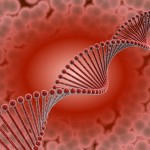LH (luteinising hormone), also known as lutropin, is an important fertility hormone which affects your ability to ovulate. It is produced in the pituitary gland and is the hormone ovulation tests measure to determine when you will be ovulating. LH has an important role throughout your entire menstrual cycle. In the first two weeks of […]
fertilisation

Estrogen
We know this is probably not a new hormone for most mums-to-be, because it’s always busy at work in the female body. However, during pregnancy this hormone ups its game and does even more than normal. Estrogen is actually a group of 3 hormones: estrone, estradiol and estriol (which the placenta produces). All three are […]

Meiosis
Meiosis is a type of cellular division in which one cell with 46 chromosomes splits into two cells, each with 23 chromosomes. It is through this process that the male sperm and female ovum (egg) are formed. Meiosis allows the sperm and egg to contribute half of your baby’s genetic information to the 46 chromosome […]

Mitosis
Mitosis is a type of cellular division which not only takes place during pregnancy, but also throughout our lives. In mitosis the DNA of each cell (which is normally made up of 46 chromosomes in a human) replicates so that there are 92 chromosomes. Once the DNA has replicated the cell splits into two diploid […]
Placenta
The placenta is a fetomaternal organ that is formed after fertilisation when the zygote implants into the mother’s uterine lining. It has 2 main components: the fetal placenta, which develops from the zygote, and the maternal placenta, which grows from the mother’s uterine tissue. The placenta grows throughout your pregnancy and at 40 weeks will […]
Embryo
Between week 3 and week 10 your baby is in the embryonic stage of his development, which means the scientific term for your baby at this time is an embryo. The development of the embryo is known as embryogenesis. The zygote which forms after fertilisation undergoes mitosis for about 5 to 7 days until it […]
Identical twins
Identical twins result from a pregnancy in which a single egg divides into two embryos after fertilisation. This means the two babies in your womb share a placenta and an amniotic sac, though some cases of multiple placentas have been reported. The egg usually divides between the first two and eight days after fertilisation, but […]
Fraternal twins
Fraternal twins result from a pregnancy in which two eggs are fertilised during conception. Two eggs means that each baby will have its own placenta and its own amniotic sac. This lowers the risks of the possible complications associated with fetuses who share these two important lifelines during pregnancy. Fraternal twins are the most common […]
Triplets and more
Though fraternal twins and identical twins are the most frequently occurring multiple births, triplets, quadruplets and even octuplets are also possibilities. The occurrence of such multiple births have greatly increased with the rise in fertility treatments. Triplets result from pregnancies in which one, two or three eggs are fertilised. This means either one egg is […]
